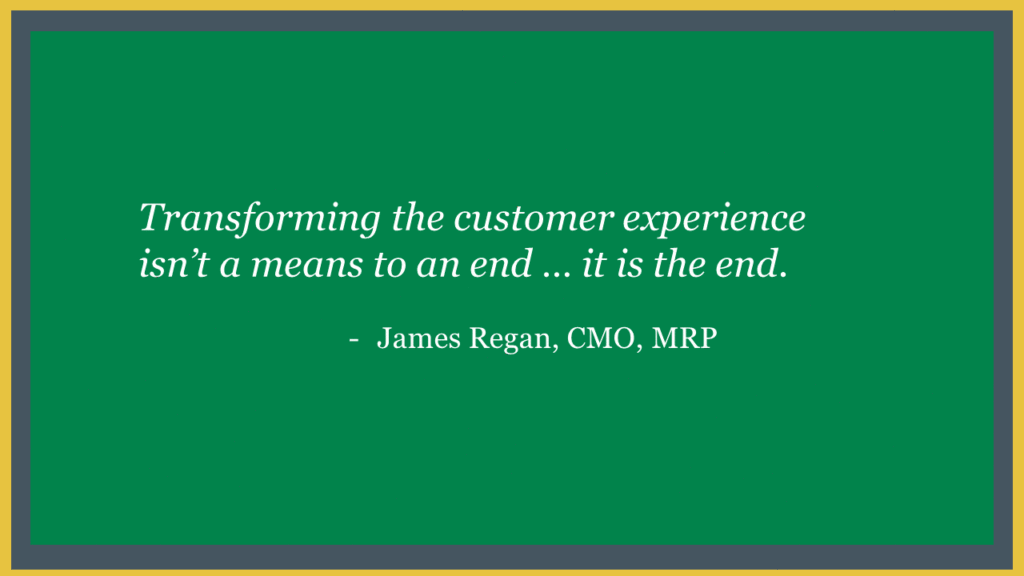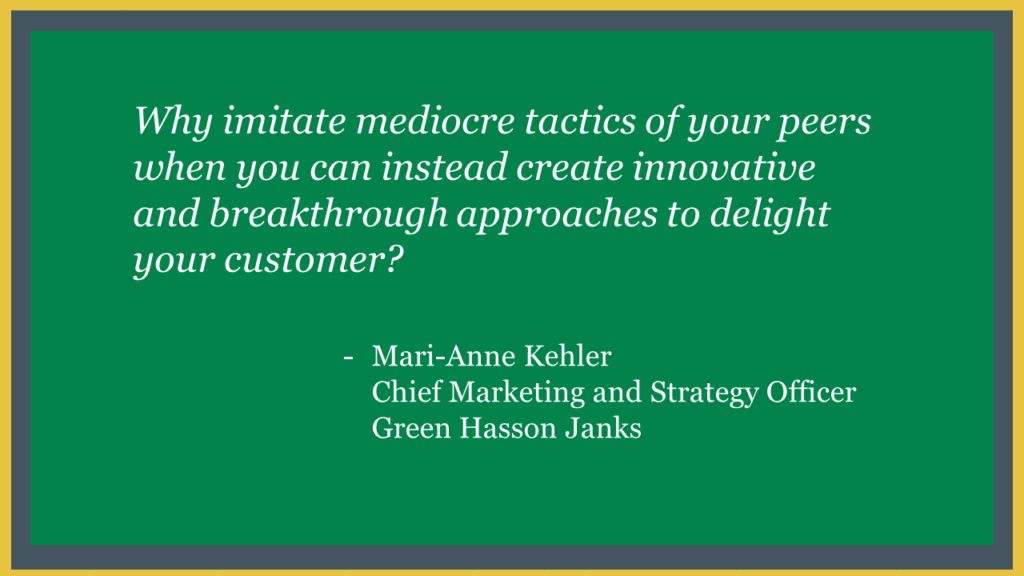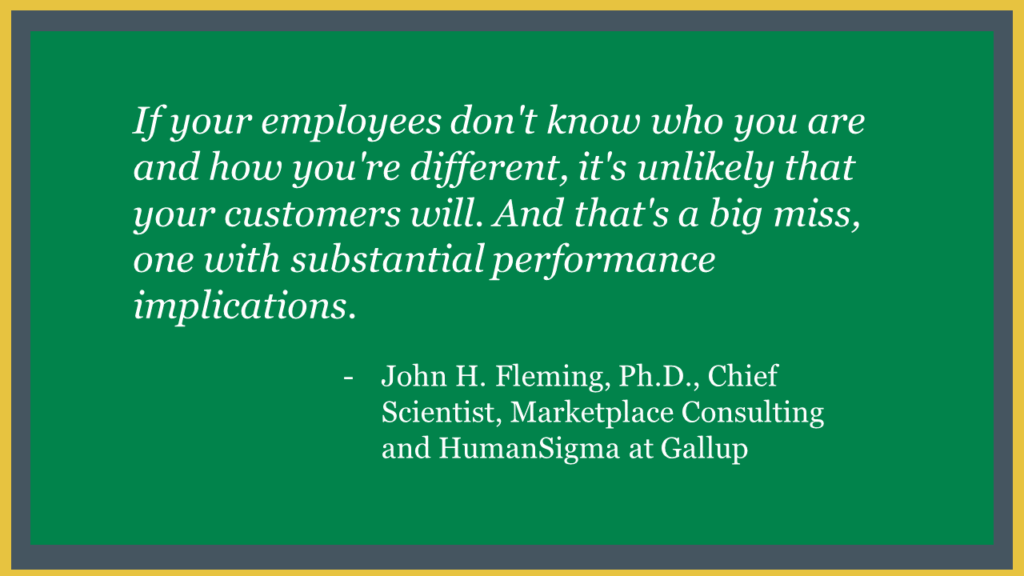Your Client Experience Matters Now More Than Ever:
Top 5 reasons 2018 can be a break-out year for B2B CMOs

Of course clients matter. That is why we’re in business: to serve our clients’ needs. At GHJ we strive to help our clients #BeMore every day. It is through understanding our clients’ needs that we are able to achieve this. But never before have we been able to understand those needs and gauge how we’re doing in fulfilling them more than now. The role of the CMO is central to this opportunity.
As technology has allowed more transparency and insight into business results, CMOs now have greater demands to prove the ROI of marketing spend. A recent Gartner study showed the role of the CMO has evolved from being the “bullhorn for the brand to actually driving profitable growth through acquisition and retention of customers, and deepening relationships with the highest value customers.”
My title happens to be Chief Marketing and Strategy Officer. But to be candid, it’s redundant. Every CMO’s role needs to include strategy, or it’s impossible to truly succeed. Gone are the days of watching competitors and mirroring their behavior. A great CMO needs to be attached to the hip of her/his CEO (or Managing Partner or whomever is in charge) to create a strategic solution that aligns with company or firm objectives. And the behavior to watch most closely is that of clients, not competitors. Why imitate mediocre tactics of your peers when you can instead create innovative and breakthrough approaches to delight your customer?
To that end, here are 5 top reasons CMOs will drive change and impact in 2018:
 1. Data and measurement
1. Data and measurement
As more CMOs are demanding access to technology and systems that provide a roadmap to success, the more they will win. Understanding customer behavior is critical to offering services and products that will elevate how we prioritize the client experience.
Transforming the client experience is a data-driven process. Data is the “how,” but growth is the “why.” The KPIs that determine marketing success should align with the company’s key objectives and measures. Overall growth is the goal, making the CMO essentially the chief growth officer if the role is properly scoped. If the CMO isn’t responsible for growth, it limits the CMO’s ability to drive sustainable success. Building brand is important, but a great brand without a growth engine will eventually stall out.
 2. Personalization technology
2. Personalization technology
Technology has advanced to the point where we now expect to customize our every experience. If we can go online and create a custom pizza with whatever topping we choose, pre-pay with a touch of a button, watch the steps of the pie being made, baked and delivered real time, and then hear the door ring within 30 minutes, of course we expect to customize our professional services offerings, too. Service standards have been defined by apps that allow us to generate immediate gratification.
CMOs need to leverage technology to find ways to personalize the client experience for their customers. Account-based marketing strategies have never been more important than now – to analyze, define and design a client experience that matches the personalized expectations of current and future clients. It starts with the data, but the CMO’s ability to analyze and convert the data into a personalized plan for each existing and future client will separate the leaders from the followers.
3. Storytelling and “why”
Customer engagement is impossible without effective storytelling. Data alone will not get you where you want to go. Yes, data is core, but content is still king. Unless you can connect the dots between what the data is telling you about clients’ needs and their experience and then communicate a message that is compelling and meaningful, your audience cannot hear you. For all the benefits technology has provided, it has also trained us to be distracted. In a world surrounded by shiny objects, it takes a strong, clear, clever and concise story to capture our attention and imagination. This makes the role of the CMO both a right-brain and left-brain job. The best CMOs must drive the science (data) and the art (storytelling) of their teams.
Easier said than done. The story starts with authenticity: telling the truth about the company or firm and knowing your “why.” As Simon Sinek so famously explained:
“…inspired organizations – regardless of their size, regardless of their industry – all think, act and communicate from the inside out.”
If you haven’t seen his 17-minute TED talk explaining the “why,” click the link and do so. It can transform your organization’s ability to define your story. My firm collaborated for a year to define our “why,” and it was a valuable journey not only for our ability to effectively message who we are, but in creating brand ambassadors at all levels and across all divisions.
4. Collaboration
No CMO can do it alone. A brand is built across channels within an organization. Said simply: marketing, talent, technology and client service teams, among others, must align if the firm’s messaging is to ring true. If silos exist, the challenge will be greater to fulfill the company’s objectives. Creating an ecosystem that allows permeable lines – allowing teams to cross boundaries and share goals – is what leads to the greatest outcomes. Does your IT team understand the needs of marketing? Does your marketing team participate in the messaging that will attract the best talent your HR team works so hard to recruit? If those kinds of cross-team collaborations aren’t in place, the CMO is missing critical tools needed to effectively penetrate the marketplace objectives placed upon her/him.
5. The CMO’s best asset
All the technology in the world cannot replace the role of relationships. Trust, quality and responsiveness provide clients what they most seek: reliable service. Every employee and company member is a brand ambassador. If they don’t know how, it’s a risk to the CMOs ability to lead the organization in sustained success. One Gallup poll showed that 41 percent of employees don’t know what their company’s branding is, which makes it significantly harder to get them on board with promoting it.
Clever campaigns will fade without the service or product to back it up. Brand ambassadors need to know their role in telling your story – the “why” of your brand. Blogging, social media and, most importantly, client interactions are all opportunities for employee engagement in the branding process. The CMO must provide the guidance and tools to shape the brand ambassadors’ journey. Done right, the impact can be exponential.

Overall, part of being a successful CMO is to help employees understand what clients need to #BeMore. Leveraging data, technology and storytelling to create a collaborative message that drives home your company’s objectives is key to this. Utilize all the tools in your tool belt so you can #BeMore of the type of leader (and CMO) you want to be.


